

Discover more from Beyond the Rood
“Here we are again! Bless me, I believe I said that before—but after all you don’t want Christmas to be different each year, do you?”1
― J.R.R. Tolkien, Letters from Father Christmas
Every year, millions of parents struggle with whether or not they should tell their children the “truth” about Santa Claus. Our modern sensibilities would have us view the story of Santa through a purely materialist lens which mocks the idea that someone like Santa Claus could actually exist. Naturally, many parents fear that enabling their child’s belief in Santa past a certain arbitrary age constitutes allowing their child to participate in a lie. Ironically, this doesn’t stop them from participating in the annual traditions that surround the story of Santa Claus, they just prefer to do so under the guise that it is all arbitrary. This fact reveals the absurdity of claiming that Santa Claus does not exist when he controls our behavior with such a commanding influence that we cannot help but pay homage to his presence every year during the Christmas season.
There is a strong tendency among faithful Christians to emphasize the separation between Santa Claus as a secular invention and the true meaning of Christmas which is the celebration of the Incarnation of Christ. And yet, there is an undeniable inseparability between the coming of Santa and the coming of Christ, such that most Christians still participate in the traditions surrounding Santa Claus alongside their ancient liturgical celebrations. How are we to understand Santa Claus and his role in the world from a Christian perspective? To answer this, we must first understand the way in which Santa Claus truly does exist.
Santa Claus as an Hypostatic Principality
The inability (or refusal) to recognize that things can exist in a manner different from how human beings, animals, rocks and trees exist is perhaps the biggest mistake the modern mind makes in coming to understand how reality lays itself out to us. Things exist beyond the level of pure material causality and Santa Claus is no different. Even in regards to purely physical reality, it is not entirely obvious how things have being and are contained in a body.2 We are composed of parts that constitute or participate in our being. Our arms, legs, hair, eyes, etc., are all parts of us, however we also recognize that we are more than the sum total of these parts.3 We say that human beings possess a human nature or essence but what bears this nature? What differentiates one human nature from another and gives it body and the ability to act in the world? It is our hypostasis or person.
The Cappadocian Fathers posited a distinction between essence (ousia) and person (hypostasis). St. Basil of Caesarea writes:
“I shall state that ousia has the same relation to hypostasis as the common has to the particular. Every one of us both shares in existence by the common term of essence (ousia) and by his own properties is such an one and such an one.”4
The theology of the Cappadocians played a crucial role in the Trinitarian debates leading up to the Council of Constantinople and it was under their influence that the formula “three hypostases in one ousia” came to be the orthodox doctrine of the Trinity.5 Likewise, St. Bonaventure says that Nestorius fell into error “because he did not know to distinguish between person and nature.”6 This distinction between essence and person is the key to understanding how God can exist in unity and multiplicity as a single divine essence in three hypostases, or how Christ can possess both a divine and human nature united under a single hypostasis.7 Although the complexities of Trinitarian ontology and Christology are beyond the scope of this essay, the same metaphysics apply to our understanding of human personhood and of the hypostasis of Santa Claus.
Borrowing from the theology first laid out by St. Basil, we can understand hypostasis or ‘person’ as an individual existence of an essence or nature. The “hypostasis and nature are related to each other in such a manner that the hypostasis is the bearer of the nature and the ultimate subject of all being and acting, while the nature is that through which the hypostasis exists and acts.”8 A nature does not act on its own but rather only through a person, and that person is the subsistence of the human essence — its “vehicle” (for lack of a better term) for being and acting in the world.
There is a temptation to reduce Santa Claus to an idea that exists only in people’s minds, but it's important to understand him not merely as a concept but as an actual hypostasis (person) because he clearly acts and has agency in the world. It is equally important to understand that he exists and has a body in a way that is much more subtle than the manner in which we exist and have a body.9 Like all principalities, because he is a spiritual being, his body is not contained like ours are and its parts exist at a much larger scale through those who participate in his being in the world.10
When a man dresses up as Santa Claus in a mall or a parent places presents under the Christmas tree for their child, they are manifesting Santa in the world as he acts in and through them.11 It's tempting for the lingering materialist in us to see these actions as “fake”, but it is important to realize that these people are not working in accordance with their own will, but with the will of Santa Claus.12 Whether it be parents placing presents under the tree, Santa Claus visiting children at the mall, or anyone embodying some aspect of Santa’s being, they are sacrificing their attention up to a higher principality. They are not trying to manifest their own will or desires but are trying to manifest the will of Santa Claus through their actions. It is not that they are pretending to be Santa, but that Santa is acting through those who give him body in this way. He is the principle that binds all of these thoughts and actions under a single cosmic entity.13
“For just as the body is one and has many members, and all the members of the body, though many, are one body, so it is with Christ.” (1 Cor. 12:12)
Those who participate in the being of Santa Claus are his “hands and feet” in a manner that is similar to what happens in the Church: “Now you are the body of Christ and individually members of it.” (1 Cor. 12:27). Through this notion, the idea of being “Santa’s helpers” takes on a whole new meaning and even provides a practical bridge between the stories about Santa Claus we tell our children and the deeper realities that they try to capture. It is truly in us and through us that Santa Claus has his being, agency, will and perception brought into corporeal reality.14 We quite literally help Santa Claus exist.
In this way, we can understand Santa Claus as the Spirit of Christmas (note the capital ‘S’). He is the essence of Christmas hypostasized (personified) and his annual manifestation to us is an incarnation or an enfleshment of the Christmas spirit. Just as Christ is an icon of God the Father (2 Cor. 4:4) meant to reveal to us the reality of God, there is a way in which Santa is an icon that reveals to us an aspect of the mystery of Christmas. He is the principality that rules over the Christmas season and his hypostasis is given a body through those who act as its parts. Participating in the body of Santa reflects our participation in the body of Christ.
I’m sure many of the Christians reading this grew up hearing the same complaints from their parents that Christ is the real meaning of Christmas and that Santa Claus is a secularized distraction meant to take away from the Christian meaning of the holiday. Perhaps this explanation of how Santa Claus exists has only solidified those concerns. To avoid offending pious ears, it should be stated clearly that Santa Claus is not the meaning of Christmas. He is however a large part of the Christmas story. While it is true that the commercialization of most Christian holidays is a distraction from their true origin and purpose (that is, Christ), this is a false dichotomy. The story of Santa Claus and the story of Christ are not competing with one another. Rather, just like the Old and New Testaments, the story of Christ is hidden in the story of Santa Claus, and the story of Santa Claus is revealed by the story of Christ.
Ritual Participation in the Story of Santa Claus
There is a bit of irony in the fact that this time of year, many Christians and non-Christians alike attempt to accomplish the same goal, namely separating the story of Santa from the story of Christ. This is problematic, however. Principalities only create a conflict when they are not brought together under God and placed in their proper place in the cosmic hierarchy.15 Any attempt to separate Santa from Christ is the heart of the problem! Not only does Santa Claus exist, he plays a fundamental role in orienting us and conforming us to Christ in this season through our participation in his story. Trying to detach Santa Claus from Christ destroys what Santa is all about.
Even in its most secularized form, the festive observances of Christmas can’t help but reflect their religious origins. The inevitability of Christ thwarts any attempts to remove the Christian meaning of the holiday. All the elements of religious ritual are present in the Christmas festivities, which themselves function like a form of liturgy. Not only are these seemingly secular Christmas traditions religious in nature, they follow many of the same fundamental patterns that traditional Christian worship and spirituality follow.
Families travel to be joined in communion and share in a communal meal where they eat and drink with one another, like a parish family travels to the Church to share in the Eucharist. The house is decorated with Christmas ornamentation which is a form of ‘sacred art’ or iconography set aside for this particular feast. Christmas carols are passed on in tradition as ‘sacred hymns’ that help communicate the proper phronema for the holiday season. Parents even make an offering of presents, milk, and cookies to Santa Claus by placing them under the Christmas tree. The tree functions as a sort of altar where these offerings are given to Santa for him to enchant ritually. This allows the items to become part of a magical feast rather than ordinary food and toys that are simply placed there by the parents. This transformation that takes place is like a miniature form of transubstantiation.
Leading up to the celebration is a period of ‘prayer and fasting’ where children are extra mindful of their behavior and even petition Santa to grant their desires either by letter or in person. In the idea that children will not receive presents unless they exhibit good behavior, there is a symbolic connection to the traditional Christian teaching that one must not receive the Eucharist if one has committed any grave sin, and not without first preparing oneself through fasting and prayer.16 This way of preparing oneself to receive the gift of Santa Claus is strikingly similar to the manner in which many Christians prepare themselves to receive the divine gift of Christ in the Eucharist.
What is seen by many to be arbitrary traditions that are devoid of any deeper meaning are actually quite pregnant with symbolic significance. All of these traditions are ritual ways in which we, as a culture, celebrate Santa Claus. “Ritual is symbolism in action”17 and these traditional rituals force people to participate in what is explicitly religious behavior because the story of Santa Claus is inseparable from the true meaning of Christmas — the story of Christ.
The story of Santa Claus is a microcosm of the story of the Incarnation of Christ. Santa descends to us from the North Pole (the highest point, the axis — which is a cross ☩) and comes down the chimney to become incarnate to us once per year during the Christmas season.18 Liturgical Christians do not merely watch the events of Christ’s life unfold from the outside, but rather, they enter into ritual participation with the story of Christ to make present again the mysteries of the Christian faith. It is for this reason that “the historical liturgy of Christendom is and always will be cosmic.”19 The sacred mysteries are not empty reenactments of historical events but are a true participation in those cosmic realities that transcend time and space.
In the same way, this mythical event of Santa’s incarnation is not something we merely observe as bystanders. It enters into our collective experience and changes the world around us. We are not called to simply watch the story unfold but to allow the story to transform us through our collective participation in it. This is the entire point of the Christmas spirit. It is an invitation into the mystery. It comes down to us and suggests a change in mindset during the Advent season, to allow our participation in the story to create a change in us. As we allow the principality of Christmas to capture our attention, we collectively become more generous, more joyful, and more grateful. Our participation in the rituals of Christmas change us just as all rituals do.20 This Christmas spirit can be seen as a form of “grace”, Santa’s self-gift to us, that leads to the positive transformation of those who synergistically allow it to change them. When one has eyes to see, it is not hard to see how the pattern of Santa Claus reflects in some small way the transformation of the world through the Incarnation of Christ.
Santa Claus — Opponent of Arianism, Defender of the Incarnation
By now, most people are familiar with the legends of St. Nicholas that garnered him the title of the “real Santa Claus”. It is of course no secret that many of the stories of “Saint Nick” served as the origin for what eventually came to be known as “Santa Claus”, which is a name derived from the Dutch nickname for Saint Nicholas “Sinter Klaas”, a shortened form of “Sint Nikolaas”.21
It is a common trick for people to claim Santa exists and then simply point to the historic figure of St. Nicholas of Myra to prove it. This is of course nothing other than a fall back to materialism that merely points to the historic existence of a real person as the origin of a legend without explaining the significance of Santa Claus as we know him today. While the etymological connection is significant, Santa Claus does not exist simply as a memory of someone who once existed. Rather, he is truly alive and active in the world today as a principality. St. Nicholas is nonetheless the symbolic link that ties Santa Claus to the story of Christ.
Historically, it is said that St. Nicholas was one of the bishops who attended the First Council of Nicea in 325 A.D. where he was a staunch opponent of Arianism and a fervent supporter of the Trinitarian doctrine and was even one of the bishops who signed the original Nicene Creed.22 There are many legends attributed to St. Nicholas and his presence at the council, including a story of him losing his temper during one of the council sessions and slapping Arius across the face.23
St. Nicholas’ presence at Nicea is far from coincidental as it relates to his historic connection to Santa Claus. Afterall, it is no mistake that a bishop who defended the divine reality of the Incarnation against the Arians with such passion is also the quintessential guardian of Christmas — the feast of the Incarnation of Christ. This is only one half of his story, however.
Perhaps the better known legends of St. Nicholas are based on him being a secret gift giver. Legend has it that one of St. Nicholas’ neighbors was a man who had three daughters. He was too poor to provide adequate dowries for them to marry so, out of desperation, the father was planning to sell his daughters into prostitution. Upon hearing this evil, St. Nicholas “threw by night secretly into the house of the man a mass of gold wrapped in a cloth.”24 St. Nicholas repeated this act of generosity three times, once for each of the three daughters. This story is what cemented St. Nicholas as a secret giver of gifts and (for obvious reasons) plays the most prominent role in the common understanding of Santa Claus today.
Herein lies the key to the mystery of Santa Claus and St. Nicholas. It is only fitting that the one who embodied the spirit of Christmas in such a prototypical manner was also a defender of Christ’s divinity and came to be known as the personification of Christmas itself. St. Nicholas is an archetype of how our participation in the story of Santa can lead to our transformation. St. Nicholas embodied what we now know as the spirit of Christmas so fully, he literally became Santa Claus. The story of St. Nicholas of Myra becoming Santa Claus is, in some sense, a microcosmic form of deification (which of course is a pale reflection of his true deification as a true Christian saint).
It can be said that just as the scriptures say we are called to become “partakers of the divine nature” (2 Peter 1:3-4), Santa Claus comes to make us partake of the nature of Christmas.
As St. Athanasius said:
“God became man, so that man might become God.”25
In some small way, just as Christ configures us to Himself by incorporating us in the Church through our participation in the sacred mysteries, Santa Claus transforms us through our participation in his works. He comes down to us once per year, takes on a body or form, and manifests himself to us so that we can share in his being and activity in the world during the Christmas season. Through our participation in his coming, the virtues of Santa Claus (kindness, generosity, compassion, charity, and joy) are all instilled in us. What is perceived as a conflict between Christ and Santa is completely undone by the reality that both are part of the same story. The transformation that takes place in us through our participation in the story of Santa is really a transformation in Christ. The principality of Christmas, Santa Claus, is subordinate to the Principality of Principalities, who is Christ — the top of the hierarchy. Just like all saints, Santa Claus points us to the God-Man.
The story of St. Nicholas becoming Santa Claus is a fractal version of a larger story of the Incarnation. Santa Claus is, to this day, defending the Incarnation of the Logos by drawing people, even unwittingly, into celebrating the Incarnation. He is not the point and purpose of Christmas, but he does participate in the true purpose of this blessed feast.
So, by all means, celebrate and participate in the story of Santa Claus this Christmas season…but don’t forget what Santa is pointing us towards — the Incarnation of the Divine Logos. Pay attention to what Santa Claus is truly trying to give to us this Christmas. Participating in the story of Santa is participating in the story of Christ, and the best way to participate in the story of Christ is through the Sacred Mysteries in the liturgy, which are truly the most divine gift.
J.R.R. Tolkien. “Letters from Father Christmas,” Mariner Books, 2004.
Pageau, Jonathan. “Santa Claus and the Tooth Fairy Exist,” at 3:42. Youtube, July, 2018
Ibid, at 3:50.
St. Basil of Caesarea. “Letter 214,” at paragraph 4.
González, Justo L. “A History of Christian Thought: From the Beginnings to the Council of Chalcedon,” at p. 307. Abingdon Press, 1987.
St. Bonaventure. “In III Sententiarum” at d.5 a.2 q.2.
Trinity Communications. “HYPOSTASIS,” Catholicculture.org.
Pageau, Jonathan. “How Principalities Can Manifest as Incarnate Persons,” at 0:43. YouTube. January, 2022.
Pageau, “Santa Claus,” at 5:18.
Ibid, at 6:02.
Ibid, at 7:01. See also Pageau, “How Principalities” at 3:15.
Pageau, Jonathan. “How Our Thoughts Relate to the Cosmic Principalities,” at 2:21. YouTube, March, 2022.
Pageau, Jonathan. “Do Principalities Have Will and Perception?” at 5:19. YouTube, September, 2018.
Pageau, “How Our Thoughts,” at 2:38.
Pageau, Jonathan. “How Ritual Relates to Symbol,” at 0:43. YouTube. March, 2021.
Pageau, Jonathan. “Why Santa Comes Down the Chimney at Night,” at 0:45. YouTube. January, 2021.
Ratzinger, Joseph. “The Spirit of the Liturgy,” at pg. 34. Ignatius Press. September, 2000.
The Lord of Spirits. “Thanksgiving,” at 300:54. Ancient Faith. November, 2022.
Amanda Onion, Missy Sullivan and Matt Mullen. “Santa Claus: Real Origins & Legends,” History.com. February, 2010. See also “Santa Claus”, etymonline.com.
Federer, William J., “There Really Is a Santa Claus – History of St. Nicholas & Christmas Holiday Traditions.” Amerisearch, Inc. at p. 26. November, 2002.
Greydanus, Steven D., “Let's Stop Celebrating St. Nicholas Punching Arius,” National Catholic Register. December, 2016.
Kosloski, Phillip. “How St. Nicholas was the first Secret Santa,” Aleteia.org. December, 2019.
St. Athanasius. “On the Incarnation,” St. Vladimirs Seminary Press. January, 2012.
Subscribe to Beyond the Rood
A look into the mysteries behind the veil.




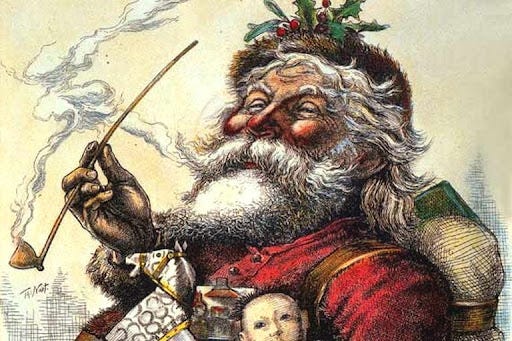
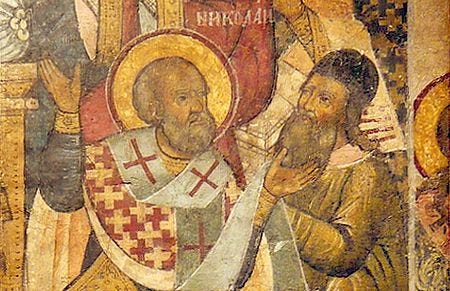
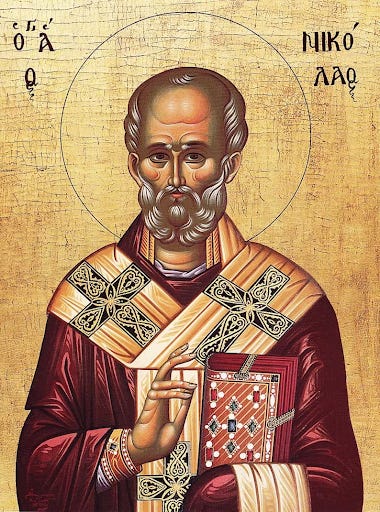
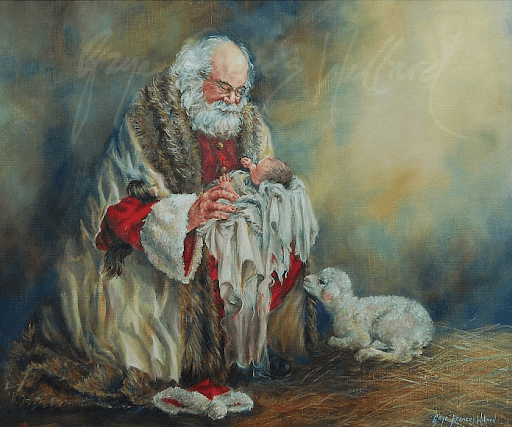






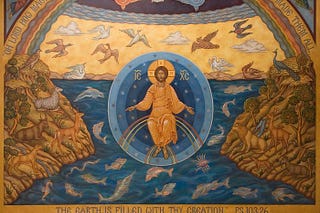
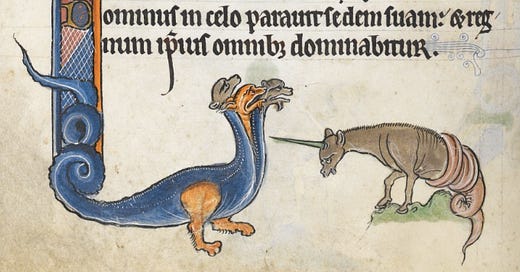



Thank you for this article! It's great to have this written out in a concise article that I can share with other people instead of trying to explain it myself, or trying to get them to watch five of Jonathan's videos, haha.
Anyways, something I was thinking while reading this: Would you say that it actually is Santa who gives children presents, as opposed to their parents, in the sense that though it is the parents who are actually purchasing/making the gifts, the parents offer the gifts up to Santa, who is the one who ultimately returns them to the children? Would this be the same pattern of how we offer our lives up to Christ, and ultimately he returns it to us with eternal life?
I'm one of Arron Iber's Patrons, and so I heard you expound Santa Claus as the Hypostasis of Christmas on his podcast before I read it on your Substack newsletter. Let me explain myself: My granddaughter-in-law and my grandson are college friends of the Ibers, and granddaughter Erin recommended Aron’s podcast to me. And, as that may tell you, I'm an old guy, eighty-two years in the making. However, I was raised in an agnostic family in an agnostic subculture and with an agnostic apprenticeship in biology (PhD 1968 University of Oregon). I was well into my career in the project of modern science, when I got Religion, and was baptized into the one, holy, Catholic and apostolic church in 1980. As an unplanned consequence, I now enjoy many grand and great grandchildren being raised in vastly more traditional Catholic families than ever we were able to offer, as my wife was as agnostic as I, and she was baptized decades after I was and after the kids had long dispersed.
I mention these personal circumstances because I have a Substack site (JBS Palmer, The Spiritual Thing), which I think you might be interested in, but you might not like it at all, because I am a theological and philosophical cobbler. Your writing in Santa Claus as the Hypostasis of Christmas is smooth flowing and majestic and your mental tools appear to be rooted in the modern Scholastic tradition. My mental tools have a very different and idiosyncratic origin. With these tools I've labored most of my life, starting as a teenager, within the project of science, to seek to comprehend the place of humanity in the cosmos.
I have now cobbled together a more or less coherent philosophical and theological conception, which I call the Myth Model. And this conception is what I'm presenting on The Spiritual Thing. However, I'm not presenting it in a reasoned expository manner, but in what I call thought verse, as opposed to poetic verse. Thought verse looks and smells a little like poetic verse but it aims, probably unsuccessfully, to show an idea to the reader which might be apprehended by his multiple intelligences. For instance, your Santa Claus appeals to multiple intelligences in your reader: literary, philosophical, theological and familial. These four modes of intelligence are like four dimensions of a space in which the object of your essay exists in itself. The orthogonal projection of the object into any of these dimensions would be a distortion of its essence. And, the space in which these dimensions themselves exist as a frame of reference, can only be that of a profound narrative. The Myth Model is like that, too.
Anyway, my vain hope is that my thought verse works like strokes of lightening (or the flashes of fireflies) to illuminate facets of both the dimensions and of the Myth Model itself which exists in them. Thought verse #17: Running With The Beagle, which is scheduled to be published this Thursday, May 4, illuminates the intuitive dawning of the role of myth—as true narrative—entering into my strictly scientific mindset. That was when I was just into my thirties as an associate professor of Biology.